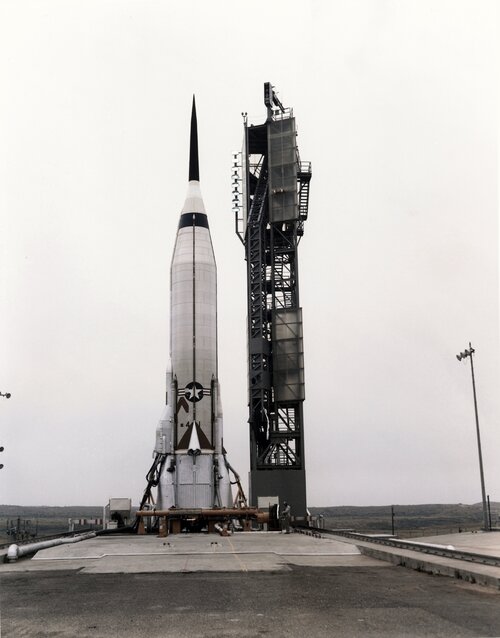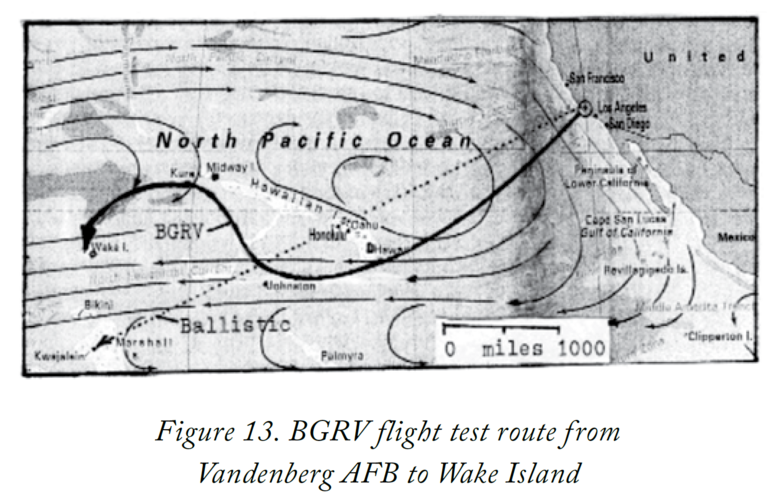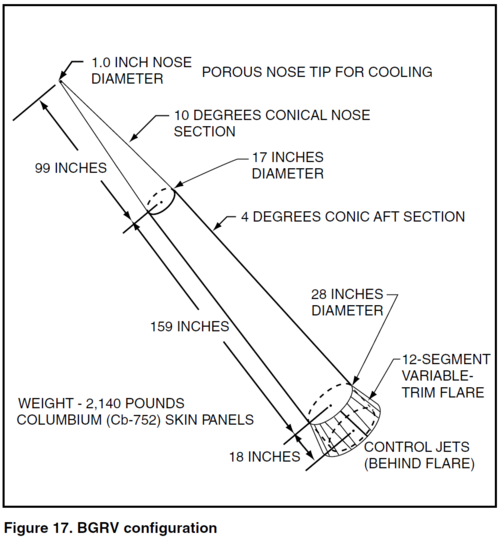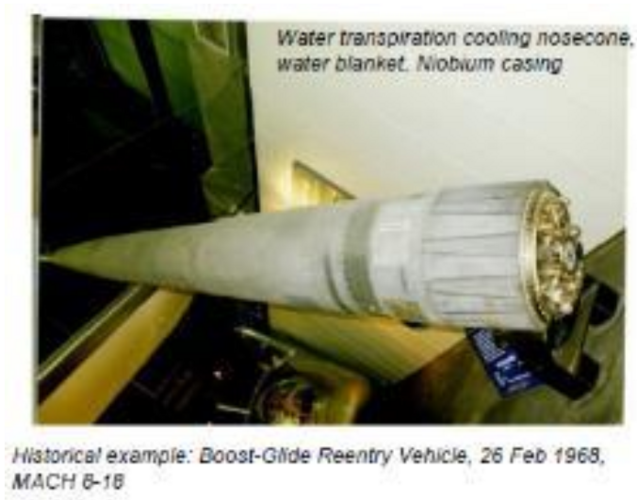Forest Green
ACCESS: Above Top Secret
- Joined
- 11 June 2019
- Messages
- 9,508
- Reaction score
- 17,401
Will that be Avangard capable?The Navy and MDA are working on GPI. Think Standard-7.
Will that be Avangard capable?The Navy and MDA are working on GPI. Think Standard-7.
Avangard is a HGV drop-in replacement for a ballistic weapon's MIRVs, the midcourse interceptors like NGI and SM-3 can take it on before the HGV has released from the upper stage or bus. But, in answer to your question, Avangard and DF-ZF have been specifically cited when MDA has discussed GPI. They know what they're up against.Will that be Avangard capable?The Navy and MDA are working on GPI. Think Standard-7.
If it glides that distance it'll take a long time to get there and be damn slow by the time it does.HGVs are not a drop in replacement for conventional RVs, that would be a MARV. In fact, Avangard is purpose-designed to counter current (i.e. exo-atmospheric) mid-course defences by taking that phase of the flight into the atmosphere. So no, SM-3 and especially NGI will almost never get an opportunity to take out a HGV before it is released from the upper stage. This happens so early into the trajectory that it would amount to a (late) boost-phase intercept - you'd have to be in exactly the right place with your mid-course interceptor launch site. Ship-launched SM-3 might actually be able to effect that against a North Korean launch or a SLBM, but it's really a fringe possibility and NGI from fixed CONUS silos is out of the question.
EDIT: Just to put this into perspective - current Avangard silos are located in Dombarovsky, Orenburg Oblast. Look that up on a map and consider that even an ICBM-boosted HGV like Avangard will have re-entered the atmosphere within ~2000km downrange of the launch site. That means it is already well into its endo-atmospheric glide toward a CONUS target by the time it even leaves Russian territory.
If it glides that distance it'll take a long time to get there and be damn slow by the time it does.


View attachment 691143
View attachment 691144
February 26, 1968
"A typical BGRV flight trajectory and footprint
is illustrated in Figure 12. In profile, the Atlas missile
would fly to an altitude of about 130,000 feet, turn to
horizontal flight to gain speed, and then would sepa-
rate BGRV on a glide-path at over Mach 15 toward
110,000 foot altitude. The vehicle would spin up, estab-
lish a lifting angle of attack to offset gravity, and glide
with little change in attitude, managing its energy to
reach the desired destination. In the target area, pro-
grammed steering equations would take over and turn
the vehicle into a terminal dive and maneuver to the
intended aimpoint."
"Dick mentioned in his briefing that five Soviet
radar and optical-tracking ships were stationed along
the flight path to monitor the event. U.S. optical-
tracking sensors obtained infrared images of the vehi-
cle, as it streaked past at an altitude of about 100,000
feet and velocity in excess of Mach 10. Vehicle telem-
etry showed the transpiration nose tip worked well
and the guidance system functioned with perfection
past Midway Island and through the “hook-slide”"
Trident RVs are designed for just that. And over longer distances the altitude is very low relative to distance for a ballistic missile due to the Earth's curvature anyway. Over 10,000km the apogee is only 1,200km, and on shorter trajectories a depressed trajectory will be used where the missile starts coming down early.Depends - it'll take about as long as (slightly quicker than, actually) a ballistic minimum energy trajectory to the same range, because that sees the conventional RV climb to such high altitude that it effectively travels a longer distance. A strongly depressed shot will be faster to the target, but that requires the warhead thermal protection system to be purpose-designed for the greater heat load (which most are not, so that's a fairly hypothetical scenario).
Terminal speed is about 60% of a ballistic RV, which is to say some 2km/s. That's not exactly damn slow, especially if you consider that (unlike a conventional warhead) it is maneuverable and has enough cross range to create significant uncertainty about its aimpoint until very late in the flight. So sure, a terminal phase interceptor that can handle HGVs is probably feasible (though no mean feat), but providing a nation-wide defence as envisioned by the US will be cost-prohibitive. You'd need far too many launchers to cover the country in its entirety.
And that's what Avangard was all about, from its inception during SDI to its current revival - rendering a national ABM shield impractical with near-term technology and thus safeguarding MAD.
Some good data here:
(Note - I disagree with many of the conclusions, or at least consider them very US-centric. If you ask what HGVs offer for the US, the answer is probably as stated in the paper, but China & Russia are not the US. For them, the ability to underfly mid-course ballistic missile defences is a perfectly valid advantage - even if the HGV can be detected. Who cares if SBIRS satellites can track it, what are you even going to do about it?)
Trident RVs are designed for just that.
And over longer distances the altitude is very low relative to distance for a ballistic missile due to the Earth's curvature anyway. Over 10,000km the apogee is only 1,200km, and on shorter trajectories a depressed trajectory will be used where the missile starts coming down early.
Terminal speed for a HGV depends on the distance you're talking about and whether the LV goes into space or stays endo-atmospheric. If it stays in atmosphere, speed will decreases rapidly with distance.
The purpose of HGVs is to make tracking and interception trickier, not to get from A to B faster.
It's a dodgy assessment. No consideration is given to size of payload, size of delivery vehicle etc. I.e. an SS-19 went from 6 warheads to one. Can you compare a single HGV on an SS-19 or 4 on an RS-28 to 10 Peacekeeper warheads, or even 3 MMIII warheads. Vastly different size missiles and since the SLBMs will have wiped out everything already, it becomes little more than a plough race. What is the size of the LV required top obtain the same range when considering a MET (Minimum Energy Trajectory) ICBM warhead. And as the paper notes, DT (Depressed Trajectory) is still faster and likely with a smaller missile and more warheads. Allow a DT ICBM and it still wins or speed.Doesn't change the fact that a HGV is (slightly) faster than a ballistic MET to the same range. Surprised me as well, but it is what it is. Nevertheless, this is not the primary motivation, I concur.
For effectiveness you really want lifting body MARV DT SLBM delivery. That would win the speed race and make for a tricky intercept. Maybe DACT for space manoeuvres too.Absolutely! That's precisely my second beef - by acting as though increased speed is the main point of HGVs, the paper is barking up the wrong tree altogether, misrepresenting the case for these systems. Though admittedly that may be a question of the intended audience, the authors specifically state that they aim to counter misconceptions about hypersonics in the general public and media. Arguably, if you aren't subject to these erroneous beliefs you can disregard.
Yet, as this thread shows, another, equally misguided view exists that dismisses HGVs as merely glorified MARVs which can be easily handled by existing BMD systems. The data is useful for refuting that argument too, so the paper is a great source nonetheless. Ironically, the point about making detection more difficult is one that would currently stand to benefit the US most, as Russia and China have not yet completed SBIRs-like EW satellite constellations. As a result they depend more on terrestrial radars (unlike the US also restricted to sites on their own territory) that HGVs can underfly.
The one I posted flew 5000 miles under 110,000ft. Over half a century ago.Terminal speed for a HGV depends on the distance you're talking about and whether the LV goes into space or stays endo-atmospheric. If it stays in atmosphere, speed will decreases rapidly with distance.
What were the start and finish speeds though? And note that is a BGRV not a HGV. 'B' being the important part.The one I posted flew 5000 miles under 110,000ft. Over half a century ago.
So the average speed is ~Mach 10, and the time taken is a lot longer than for a regular ICBM.The 122E BGRV started its glide at a Mach number near 20 and maintained hypersonic flight for 5,000 miles, which takes about 45 minutes.
Nice.
Another way to penetrate Soviet last-ditch defenses was to have a BGRV pull out of its dive and conduct a low-level run-in at 500 feet for 25 miles to the target at Mach 10 using the terrain contour matching (TERCOM) navigation system.
The pullout and run-in environment is extremely severe, with the temperature at the nose reaching 5,000º C.
It's a dodgy assessment. No consideration is given to size of payload, size of delivery vehicle etc. I.e. an SS-19 went from 6 warheads to one. Can you compare a single HGV on an SS-19 or 4 on an RS-28 to 10 Peacekeeper warheads, or even 3 MMIII warheads. Vastly different size missiles and since the SLBMs will have wiped out everything already, it becomes little more than a plough race. What is the size of the LV required top obtain the same range when considering a MET (Minimum Energy Trajectory) ICBM warhead.
And as the paper notes, DT (Depressed Trajectory) is still faster and likely with a smaller missile and more warheads.
For effectiveness you really want lifting body MARV DT SLBM delivery. That would win the speed race and make for a tricky intercept.
What were the start and finish speeds though? And note that is a BGRV not a HGV. 'B' being the important part.
"In profile, the Atlas missileI suppose the Atlas rocket carrying the BGRV only conducted its pitch-over manoeuvre after it had shutdown its' booster rocket-motors and jettisoned its' thrust structure mounting them?
RV is the Mk-21 W87 is the warhead. The Sentinel will carry the W87-1 on an Mk-21a RV for example.It's a dodgy assessment. No consideration is given to size of payload, size of delivery vehicle etc. I.e. an SS-19 went from 6 warheads to one. Can you compare a single HGV on an SS-19 or 4 on an RS-28 to 10 Peacekeeper warheads, or even 3 MMIII warheads. Vastly different size missiles and since the SLBMs will have wiped out everything already, it becomes little more than a plough race. What is the size of the LV required top obtain the same range when considering a MET (Minimum Energy Trajectory) ICBM warhead. And as the paper notes, DT (Depressed Trajectory) is still faster and likely with a smaller missile and more warheads. Allow a DT ICBM and it still wins or speed.Doesn't change the fact that a HGV is (slightly) faster than a ballistic MET to the same range. Surprised me as well, but it is what it is. Nevertheless, this is not the primary motivation, I concur.
For effectiveness you really want lifting body MARV DT SLBM delivery. That would win the speed race and make for a tricky intercept. Maybe DACT for space manoeuvres too.Absolutely! That's precisely my second beef - by acting as though increased speed is the main point of HGVs, the paper is barking up the wrong tree altogether, misrepresenting the case for these systems. Though admittedly that may be a question of the intended audience, the authors specifically state that they aim to counter misconceptions about hypersonics in the general public and media. Arguably, if you aren't subject to these erroneous beliefs you can disregard.
Yet, as this thread shows, another, equally misguided view exists that dismisses HGVs as merely glorified MARVs which can be easily handled by existing BMD systems. The data is useful for refuting that argument too, so the paper is a great source nonetheless. Ironically, the point about making detection more difficult is one that would currently stand to benefit the US most, as Russia and China have not yet completed SBIRs-like EW satellite constellations. As a result they depend more on terrestrial radars (unlike the US also restricted to sites on their own territory) that HGVs can underfly.
Interestingly the document also assumes an apogee of 1,300km for an 8,000km minimum range. The LGM-118 was quoted at 1000km for 10,000km.
LGM-118A intercontinental ballistic missile - MX | Missilery.info
In 1972 a special governmental commission was engaged in research of prospects of development of strategic nuclear forces of the USA till the end of 20th century. As a result of its work, theen.missilery.info
Additionally, don't the current MMIIIs presently carry the same W87 RVs as the MXs did?
Is Sentinel not going with a MaRV?RV is the Mk-21 W87 is the warhead. The Sentinel will carry the W87-1 on an Mk-21a RV for example.
How does it compare to a HGV though? Obviously it's unfavourable compared to MET for size/weight. I mean the thing with lift is that it's impossible to create without adding drag, so with a HGV you have more drag and more time in atmosphere, so it would still require a larger booster for the same range.Nope, the payload or range penalties are very severe for a depressed trajectory. To get a rough sense:
If it's over a short enough range, it's doubtful that the reaction time will be fast enough. And even then, endo-atmospheric DACT/boosters on the MaRV would complicate interception.... but still be vulnerable to existing mid-course interceptors, which renders the whole thing pointless. Again, time-of-flight isn't what HGVs are about in the first place.
Yes, but it also had a booster incorporated on the HGV, hence BGRV. And it took 45 minutes to do 8,000km, which is about 1.6x as long as a regular ICBM. I think a lot of studies make very different assumptions about the boost phase altitude and exact flight profile of HGVs. BGRV flew entirely in atmosphere and took 45 minutes to do 8,000km.What were the start and finish speeds though? And note that is a BGRV not a HGV. 'B' being the important part.
BGRV WAS an HGV. Not sure what you're trying to say here.
Don’t know they only give it the Mk-21A moniker as a “modified” Mk-21. There’s no mention it’s a MaRV.Is Sentinel not going with a MaRV?RV is the Mk-21 W87 is the warhead. The Sentinel will carry the W87-1 on an Mk-21a RV for example.

 www.thedefensepost.com
www.thedefensepost.com
First flight test failed (booster not RV)
Yes, but it also had a booster incorporated on the HGV, hence BGRV. And it took 45 minutes to do 8,000km, which is about twice as long as a regular ICBM. I think a lot of studies make very different assumptions about the boost phase altitude and exact flight profile of HGVs. BGRV flew entirely in atmosphere and took 45 minutes to do 8,000km.
ALL HGVs have boosters. They don't just teleport themselves to flight conditions. And yes, it flew 8,000 km in 45 minutes, and while it did slow down from weapon release to impact 8000km later, it was still traveling at high hypersonic speeds at impact.Yes, but it also had a booster incorporated on the HGV, hence BGRV. And it took 45 minutes to do 8,000km, which is about twice as long as a regular ICBM. I think a lot of studies make very different assumptions about the boost phase altitude and exact flight profile of HGVs. BGRV flew entirely in atmosphere and took 45 minutes to do 8,000km.What were the start and finish speeds though? And note that is a BGRV not a HGV. 'B' being the important part.
BGRV WAS an HGV. Not sure what you're trying to say here.
The thing did not remain attached to Atlas the entire flight. "Burnout" velocity of Atlas is irrelevant. Release velocity (Mach 15) is what matters.Yes, but it also had a booster incorporated on the HGV, hence BGRV. And it took 45 minutes to do 8,000km, which is about twice as long as a regular ICBM. I think a lot of studies make very different assumptions about the boost phase altitude and exact flight profile of HGVs. BGRV flew entirely in atmosphere and took 45 minutes to do 8,000km.
Boost refers to the Atlas launcher...
It was comparatively slow because its L/D was worse than modern lifting body HGVs, so it suffered more deceleration over the course of its glide. The fairly major s-turn will have exacerbated this. Burn-out velocity of the Atlas may have been lower too, especially if it really didn't leave the atmosphere.
How does it compare to a HGV though? Obviously it's unfavourable compared to MET for size/weight. I mean the thing with lift is that it's impossible to create without adding drag, so with a HGV you have more drag and more time in atmosphere, so it would still require a larger booster for the same range.
If it's over a short enough range, it's doubtful that the reaction time will be fast enough. And even then, endo-atmospheric DACT/boosters on the MaRV would complicate interception.
No I believe they were testing the RV on a Minotaur II stack. I think first Sentinel test is late this year.First flight test failed (booster not RV)
I'm a bit confused, I thought the article was about the first flight-test of the Mk-21A RV? So was the first XLGM-35A Sentinel missile prototype tested last year?
Wasn't there also a booster (i.e. propulsion) integrated on the BGRV itself though? That was my understanding anyway.ALL HGVs have boosters. They don't just teleport themselves to flight conditions. And yes, it flew 8,000 km in 45 minutes, and while it did slow down from weapon release to impact 8000km later, it was still traveling at high hypersonic speeds at impact.
This paper (page 9) states a maximum range of 4,000km gliding at a much high altitude with an entry speed of 5km/s, which is approximately Mach 15.The thing did not remain attached to Atlas the entire flight. "Burnout" velocity of Atlas is irrelevant. Release velocity (Mach 15) is what matters.
Is it not the case that other factors also played a part, like the fact it was endo-atmospheric the whole flight. In the study you linked, the glider doesn't really get below the 70-80km altitude where drag becomes an issue until after about 2,500km over an 8,000km flight, and remains above 100km for the first 2,000km. Equally, without such a manoeuvre, the HGV would remain on a very predictable/interceptable course, albeit in atmosphere.Boost refers to the Atlas launcher...
It was comparatively slow because its L/D was worse than modern lifting body HGVs, so it suffered more deceleration over the course of its glide. The fairly major s-turn will have exacerbated this. Burn-out velocity of the Atlas may have been lower too, especially if it really didn't leave the atmosphere.
On the Mk-21A:RV is the Mk-21 W87 is the warhead. The Sentinel will carry the W87-1 on an Mk-21a RV for example.
The Mk21A Reentry Vehicle (RV) program will design, develop, produce and deploy an integrated RV capable of delivering the W87-1 Warhead when released from the Ground Based Strategic Deterrent (GBSD) Intercontinental Ballistic Missile (ICBM). The Mk21A will provide needed performance and security enhancements over the Mk21 reentry vehicle to meet the upgraded requirements for the Department of Energy W87-1 warhead. The Mk21A will also meet the requirements laid out in the Ground Based Strategic Deterrent (GBSD) Capability Development Document (CDD) as directed by Air Force Global Strike Command.
The paper only goes to 8600km range. The D5 can do 12,000km with 4 warheads can't it? Or are you referring to 8600km on a DT, which is probably a scenario that wouldn't arise?If your L/D is favourable you can maintain speed for longer though because you are able to remain at high altitude (=low atmospheric density) until basically overhead the target. That's exactly what enables your much vaunted lifting RV on a DT to maintain a speed advantage down to impact. A ballistic descent will otherwise decelerate something awful and arrive at the surface *slower* than either the HGV diving from cruise altitude or a conventional MET RV with a steeper reentry angle.
As for launcher size, the fastest and highest trajectories in that paper on DTs require the Trident to be offloaded to a single heavy RV (but then Avangard reportedly carries a megaton-class warhead, so fair enough). Or even a notional, more powerful delivery vehicle that is capable of boosting a full 2800kg Trident payload to far in excess of orbital velocity. To put that into perspective, the R-36O FOBS had a payload of 1700kg and was three times the weight of a Trident, despite higher-impulse liquid propellants...
So, not good - at all. Makes you wonder what kind of payload it was that the other paper was launching to get 8000km range on a DT out of a Minotaur IV - a kitchen knife?
Calculated flight paths of a hypersonic glider and a ballistic missile flying minimum energy and depressed trajectories, fired at a target 8,100 km down-range. All missiles use identical Minotaur IV boosters.
Well that is the nature of a fast delivery, yes, but you could probably do the same with an ICBM MaRV but the warning time would obviously increase, and I guess you would have to program it with some way of knowing when to manoeuvre, so as not to waste fuel.That means you cannot use it on an ICBM though, and must expose your launch platform (whatever it is - submarine, strategic bomber) to vastly greater risk of destruction "left of launch".
I was certainly NOT suggesting that it did! And as BGRV itself is unpowered, I'm not sure how you'd effect release before the Atlas has burned out...
This seems to mention control jets behind the flare (page 167)??

Control was provided by a 12-piece, segmented, variabletrim
flare and small rocket thrusters mounted on a spherical
aft end behind the flare. Individual control flaps, as depicted in
the NACA glide vehicle concept in figure 9, could not withstand
the severe heating, so the flare/thruster system was designed.
The flare changed the vehicle trim angle of attack, and the
thrusters provided angle-of-attack transient control. Like the
122B Alpha Draco, the 122E was slowly rolled to provide uniform
heat distribution. Guidance was provided by an inertial
navigation system and digital computer.
There was the BGRV, with the Atlas booster, and the similar looking Alpha Draco with a different booster. BGRV did not have an integral motor.Wasn't there also a booster (i.e. propulsion) integrated on the BGRV itself though? That was my understanding anyway.ALL HGVs have boosters. They don't just teleport themselves to flight conditions. And yes, it flew 8,000 km in 45 minutes, and while it did slow down from weapon release to impact 8000km later, it was still traveling at high hypersonic speeds at impact.
Thrusters for directional control. The thing was no more powered than a KKV axially.I was certainly NOT suggesting that it did! And as BGRV itself is unpowered, I'm not sure how you'd effect release before the Atlas has burned out...This seems to mention control jets behind the flare (page 167)??
View attachment 691274
Page 168:
Control was provided by a 12-piece, segmented, variabletrim
flare and small rocket thrusters mounted on a spherical
aft end behind the flare. Individual control flaps, as depicted in
the NACA glide vehicle concept in figure 9, could not withstand
the severe heating, so the flare/thruster system was designed.
The flare changed the vehicle trim angle of attack, and the
thrusters provided angle-of-attack transient control. Like the
122B Alpha Draco, the 122E was slowly rolled to provide uniform
heat distribution. Guidance was provided by an inertial
navigation system and digital computer.

